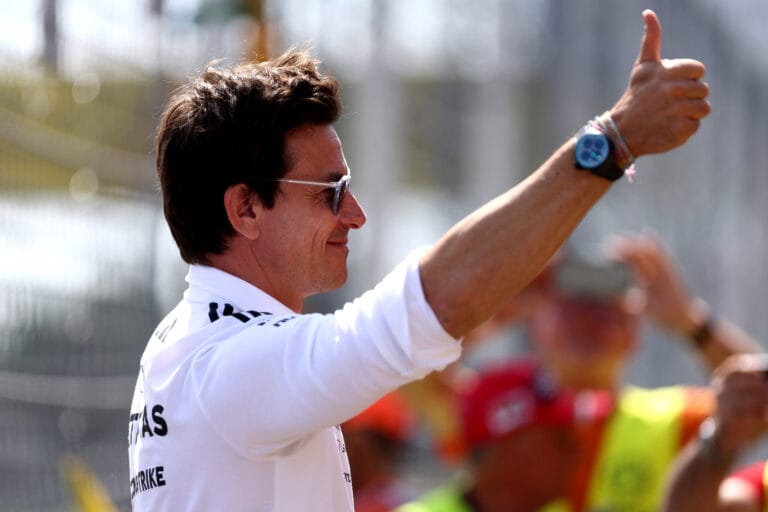It’s astonishing how much Formula 1 cars have evolved since the first official Grand Prix in 1950. We’ll take you on a whirlwind tour through the technical and innovative transformations these speed demons have undergone over the past 75 years.
1950s
Cigars on Wheels
The very first Formula 1 races were driven in cars that most closely resembled cigars on wheels. Take the Alfa Romeo 158, with which Giuseppe Farina became world champion in 1950: the engine was in the front, there were no wings, narrow profile tires, and a driver in a woolen sweater with a leather helmet. And seat belts? They were considered dangerous. Imagine getting stuck in one while trying to jump out of the car during a crash. Aerodynamics and electronic aids were still a thing of the future. No, this period was all about raw power, mechanical grip, and courage. A lot of courage.
1960s
Major Breakthroughs
In the 1960s, teams like Cooper discovered that you could get much more out of a car if you placed the engine not in front but behind the driver. This way, the weight was better distributed and the car steered much tighter. It seems obvious now, but it was a revolutionary development. Enzo Ferrari didn’t like it. “Horses pull the cart, they don’t push it,” grumbled the Italian, who eventually gave in.
Aerodynamics also slowly made its entrance. By the end of the decade, the first little wings appeared. Lotus, led by the brilliant Colin Chapman, was at the forefront of this. The British team began experimenting with small wings that pressed the car onto the asphalt. Chapman also introduced the ‘monocoque’ chassis. The driver thus sat in a kind of aluminum bathtub that was much lighter, stiffer, and safer than the old tubular frame. It was a precursor to what all modern race cars use today.
The 1970s
Searching for Grip
The wings prove to be a hit, and in the 1970s, every effort is made to gain even more advantage in the field of aerodynamics. It is then that (once again) Lotus discovers the ‘ground effect’. By cleverly shaping the underside of the car, it essentially sticks to the asphalt. The result is an incredible amount of grip in corners. Other teams quickly follow the example of the nearly unbeatable Lotus 78 and 79.
This period also sees some wild experiments. Consider, for example, the six-wheeled Tyrrell P34 or the Brabham ‘fan car’. The team has attached a large fan to the back of the car to suck the air from underneath for extra downforce. Niki Lauda wins immediately during the debut of this unique car, but the FIA decides to ban the Brabham BT46 after just one race.
The 1980s
Turbo Power
After Renault’s trial and error attempts in the 1970s, turbo power truly comes into its own. Ferrari, McLaren, and Williams unleash small 1.5-liter turbo engines that deliver an astonishing amount of power. Some manufacturers even manage to squeeze out more than 1400 horsepower from special qualifying blocks! It’s an insane time in Formula 1, but the engines frequently blow up and safety becomes a matter of concern.
Additionally, electronics start to play an increasingly prominent role. Systems such as active suspension, traction control, and the first semi-automatic gearboxes make their debut. Moreover, McLaren sets a new standard in Formula 1 with the MP4/1, the first F1 car with a carbon fiber chassis. It’s not only super light but also super strong. It doesn’t take long for other teams to follow suit.
The 1990s
Safety
In the early nineties, F1 takes a technological leap forward with systems like launch control, ABS, and the perfection of active suspension. Williams, in particular, has this down to a fine art, and the FW14B can even adjust its own height and stiffness while driving. The FIA believes that the driver is being replaced too much and bans all these overly helpful electronics from 1994 onwards.
After the fatal accidents in Imola in 1994, serious attention is finally given to safety in Formula 1. Not only are the circuits made safer, but the cars are also overhauled. Numerous changes are implemented, such as larger and raised cockpit openings, and the cars are made much sturdier to better absorb the impact during a crash. To prevent the cars from racing too low over the asphalt, a wooden plank is screwed under the car that must not wear down too much. This practice is still in use today.
The 2000s
Introduction of KERS
In 2006, Formula 1 bid farewell to the V10 engines, with all teams transitioning to V8 blocks. This was done to further curb speed and improve reliability. Aerodynamics were developed to the extreme, with numerous wings, bargeboards, and diffusers. However, as this created a lot of dirty air, aerodynamic restrictions were implemented in 2009. The cars were given flat and simple bodywork, a wide front wing, and a narrow rear wing. The first hybrid innovation, KERS (Kinetic Energy Recovery System), was also introduced, which stored braking energy that could be used as a boost for extra speed.
The 2010s
The Hybrid Era
At the start of the decade, DRS was added to the cars. In 2014, Formula 1 underwent a radical change. The V8 engines were replaced with V6 turbos equipped with advanced hybrid systems. These produced significantly less noise, unfortunately, but were also very complex. Engines were not only equipped with ERS (the successor to KERS), but also with MGU-K (kinetic energy) and MGU-H (heat energy) for energy recovery. This made Formula 1 cars the most efficient combustion engines in the world. Mercedes, in particular, mastered this technology, leading to dominant years with Lewis Hamilton at the wheel.
“At the same time, the sport becomes even safer. In 2018, the Halo is introduced, a titanium protection bar above the driver’s head. Initially, the ‘flip-flop’ is reviled, but after saving lives in a few major crashes, it quickly gains respect.
The 2020s
Sustainability
We have now entered the era of sustainability. The engines and parts must last even longer, and a budget cap is introduced. The exorbitantly high costs of the top teams are now a thing of the past. Furthermore, the teams now use more standard parts to reduce costs. Also, the cars no longer run on 13-inch but on 18-inch tires to be more relevant to the automotive world.
In 2022, new rules are introduced that overhaul the aerodynamics. Wings become simpler, and the ‘ground effect’ returns with the aim of being able to race closer together to increase the tension. Never before has the Formula 1 field been as close together as it is today.
At the same time, the sport is also looking ahead. In 2026, new engine rules will be introduced, with even more emphasis on sustainable fuels and electric power. Formula 1 even aims to be completely CO2-neutral by 2030. Whether you are a supporter or opponent of the developments, after 75 years the essence of the sport remains the same: to race across the asphalt as quickly as possible.
“









